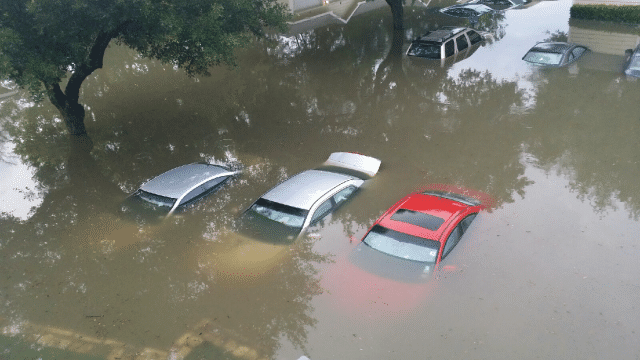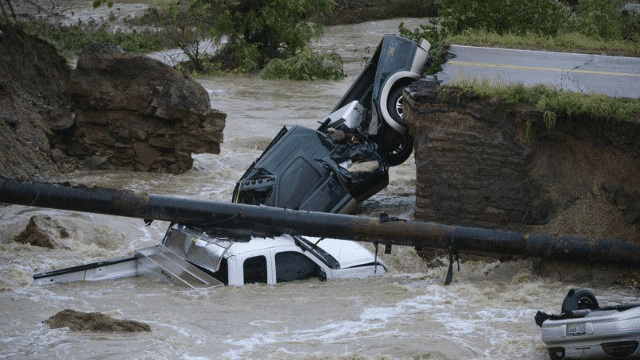Tips on How to Drive Through Flooded Roads

There are times when you don't have a choice but to drive through a flood. When floodwaters are rising fast, or your car is in danger of getting swept by a strong current, then you need to act fast*.
Here are some tips on how to lessen the amount of damage you'll sustain when you drive through a flood:
 @http://ww1.hdnux.com
@http://ww1.hdnux.comFirst Things First: Consider the Dangers
Make sure to assess if you really want to risk driving through floods in the first place. Here are the possible dangers that you might encounter if you do decide to go through with it:
- Water and electricity never mix, so this can damage your car's electronic components and modules, especially for petrol cars.
- The engine can suck in water and cause hydraulic locks that can damage pistons and connecting rods. This is especially true for cars that have air intakes that are placed low on the engine bay. The most vulnerable engines here are diesel and turbocharged petrol engines.
- It can give way to a moldy smell inside your car.
- Metal parts can get rusty and corroded.
Start with the Right Car
Remember that water can increase in depth as soon as you start driving -- no matter if it started with a mere two or three inches in height. Take this into serious consideration, especially if your car has a low wheelbase height to begin with.
Vehicles that have a much better chance in floods include SUVs (Sport Utility Vehicles) Jeeps, and pickup trucks with high ground clearance. Manual transmission cars and diesel automatic engines also have better chances of wading in safely through the floods.
Proceed with Extreme Caution
 @http://i.f1g.fr
@http://i.f1g.frOnce you've decided to go through with it, then here are some tips on how to lessen the damages:
1. Check out your surroundings first. Observe other cars and see how they navigate through the floods. Also look for exposed telephone lines nearby. If that's the case, then it's best not to proceed with it.
2. Turn on your headlights so you can have a much clearer idea of how deep the water is.
3. You can also open your car and check to see the water's depth. If the standing water is around or less than 6 inches, (or 4 inches when it's moving water), then you can continue. You can also follow this (very) general rule:
- Sedans, Hatchbacks, City Cars, Bikes - water level should be in between the ankle and knee.
- SUVs and Jeeps (without a snorkel) - water shouldn't go above the knee or thigh
- SUVs and Jeeps (with a snorkel) - any water level is fine (especially for those with a high wheel base)
- Manual and Diesel-Automatic car engines - water level should be in between the ankle and knee.
4. If you still can't estimate the depth, it's best not to continue with it. Still, if you really need to, then--
5. Check for swirling or rushing water. Oftentimes, swirling water means an open hole or even a sewer, which can be dangerous. Create a mental map of where they are, and avoid driving near them.
6. Start the engine and move at a snail-pace first, around 1-2 mph. Drive slow and steady. You don't want to disturb the water too much and risk water entering in the exhaust pipe. Maintain this speed consistently if your car isn't a large SUV or truck, or your 4x4 has beam axles.
7. Those with large 4x4s can accelerate for up to 3-4 mph, since they can create space around the engine bay and keep the water from coming inside the air intake.
8. Whenever possible, try to stay at the crown's center line, which is the middle part of a road that's at the highest point in its slope. This gives you lesser chances of water coming inside your car's engine.
If there's no center line, just drive at the highest part of a slope.
 @https://activerain-store.s3.amazonaws.com
@https://activerain-store.s3.amazonaws.com9. Maintain your car at first gear, and keep the revs up by slipping the clutch. Otherwise, you risk letting water inside the exhaust system, which can stall the engine.
10. Remember: don't drive fast in standing water. This can result to aquaplaning, which makes you lose control over your steering.
 @http://www.readingeagle.com
@http://www.readingeagle.com11. If you feel your wheels are starting to lose grip while driving, then it can be a sign that it's starting to float. When this happens, ask a passenger to open the door to allow some water to come inside. This will add more weight to it and enable the tires to increase their grip. Do this while continuously revving up your engine and slipping the clutch.
What to Do After
Gently tap the brakes after driving through a flood to see if they're still working properly. Do this while still driving slowly. Once you get home, inspect the radiator for stuck leaves or other debris inside, and take them out accordingly.
Make sure to check the car in the days that follow for mold smells or weird engine noises. You can also have it checked by a car mechanic just to be safe.
In the future, consider installing a snorkel to your Jeep or SUV to make it easier for your car to drive through deep floods.
--
*Driving through floodwaters is dangerous. In fact it's always better to stop your engine or look for an alternative route instead of wading through floodwaters head-on.
Featured Articles
- Latest
- Popular
Recommended Articles For You
Featured Cars
- Latest
- Upcoming
- Popular
Car Articles From Zigwheels
- News
- Article Feature
- Advisory Stories
- Road Test

